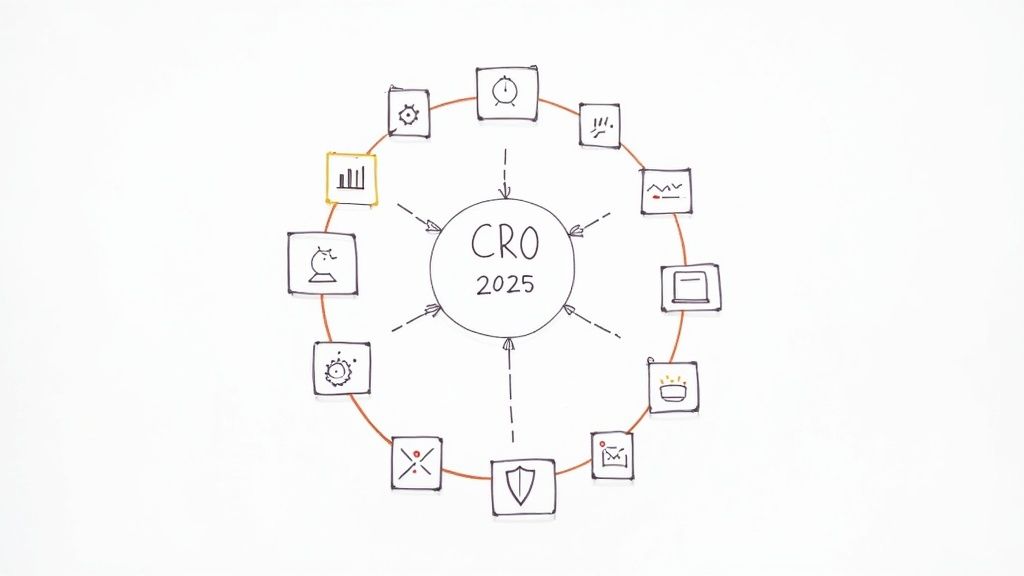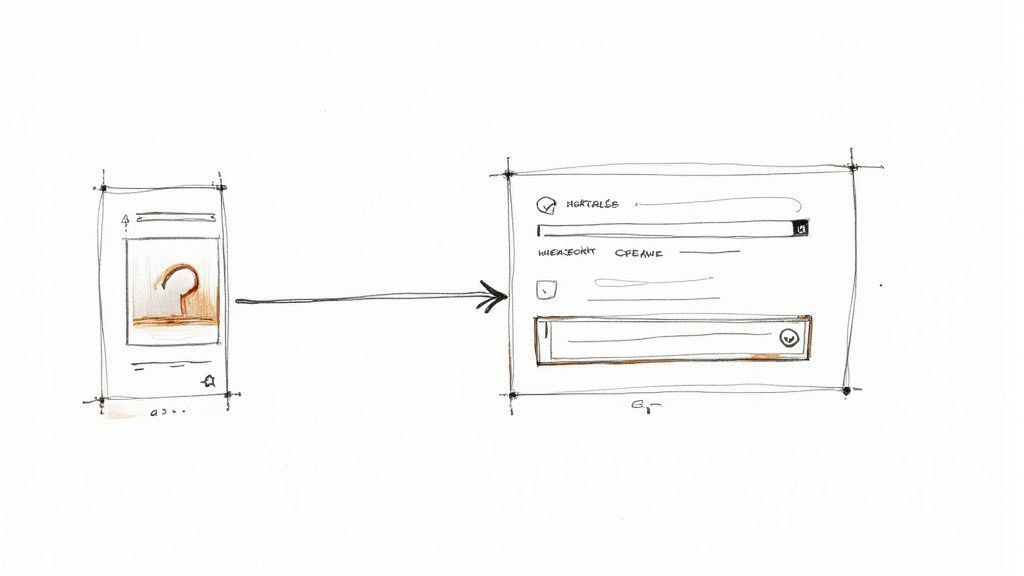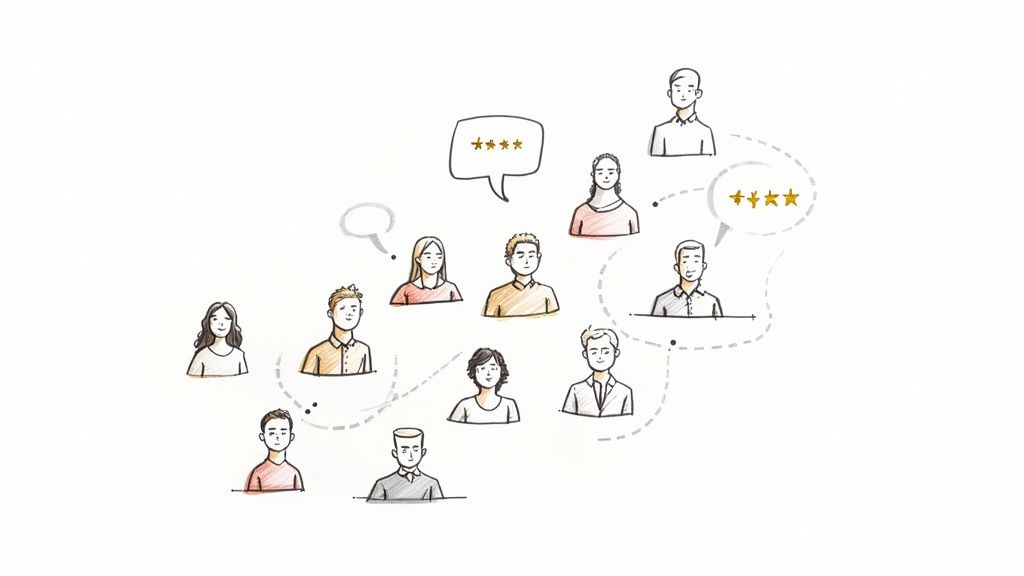
How to Improve Customer Engagement for SMBs
Discover how to improve customer engagement with practical strategies. Learn to personalize experiences, use AI, and build lasting customer loyalty.

In digital marketing, traffic is just the beginning; conversion is where value is truly created. Simply getting people to your website isn't enough—you need them to take action. This is where Conversion Rate Optimization (CRO) comes in. It's the systematic process of increasing the percentage of website visitors who complete a desired goal, whether that's making a purchase, filling out a form, or signing up for a newsletter.
A higher conversion rate means more sales, more leads, and a better return on your marketing investment without spending more on acquiring traffic. It’s about making your existing funnel more efficient. To begin your journey towards turning more visitors into customers, consider this comprehensive guide to improving ecommerce conversion rates.
This guide dives deep into 10 proven conversion rate optimization best practices that move beyond generic advice. We'll provide actionable steps, real-world examples, and data-backed insights to help you transform your website into a high-performance conversion engine. We’re focusing on specific strategies you can implement immediately to see measurable growth and turn more of your hard-earned traffic into loyal customers. Let's get started.
A/B testing, also known as split testing, is a foundational method in conversion rate optimization. It's a controlled experiment where you compare two versions of a webpage or app element to see which one performs better. In this process, you split your audience randomly, showing half of them the original version (the "control") and the other half a modified version (the "variation"). By tracking user behavior, you can definitively identify which version leads to better results.

This scientific approach removes guesswork, allowing you to make data-driven decisions. For example, Netflix famously A/B tests different thumbnail images for its shows to see which one encourages more clicks. Similarly, e-commerce giant Amazon continuously tests everything from button colors to checkout flow layouts to incrementally improve its conversion rates.
A clear value proposition is one of the most critical conversion rate optimization best practices. It's a concise statement that immediately communicates the unique benefit a customer will get from your product or service. This crucial element answers the visitor's core question: "What's in it for me, and why should I choose you?" When executed well, it's prominently placed above the fold on your homepage or landing page, instantly grabbing attention.
This strategic messaging cuts through the noise. For example, Slack’s famous "Where work happens" immediately positions it as a central hub for professional collaboration. Similarly, Stripe's "Payments infrastructure for the internet" clearly defines its purpose and audience. This clarity is essential for guiding users toward a conversion.
A frictionless checkout process is a critical component of CRO, designed to minimize the steps and effort required to complete a purchase. By simplifying the path from cart to payment, businesses can dramatically reduce cart abandonment rates. This optimization focuses on removing any obstacle that might cause a potential customer to leave before buying.

The goal is to make the transaction feel seamless and secure. For instance, Amazon's patented One-Click purchasing is a prime example of reducing friction. Similarly, Shopify stores benefit from a highly optimized checkout flow that builds customer trust. By streamlining this final step, you ensure that interest converts into revenue. For a deeper dive, learn more about how to increase ecommerce conversion rates on brandboosteraa.webflow.io.
Your Call-to-Action (CTA) is the gateway to conversion, guiding users from passive browsing to active engagement. Strategic CTA design is a crucial aspect of conversion rate optimization best practices, encompassing the button's copy, color, size, and placement. An effective CTA is visually striking, clearly communicates value, and prompts the user to take the next logical step.
This focused approach turns a simple button into a powerful conversion tool. For example, Slack uses a prominent, high-contrast green "Try for Free" button that stands out on its homepage. Similarly, Spotify places its "Get Premium" CTA strategically above the fold. By optimizing these critical elements, you make it easy for users to say "yes."
Social proof is a psychological principle where people assume the actions of others reflect correct behavior. As one of the most powerful conversion rate optimization best practices, it helps overcome a visitor's skepticism by showing that others have trusted and valued your product or service. By displaying testimonials, reviews, and certifications, you build credibility and reduce friction in the decision-making process.

This method effectively answers the visitor's subconscious question: "Why should I trust this company?" For example, Amazon prominently displays star ratings and review counts on every product page. Similarly, SaaS companies like Basecamp feature detailed case studies and customer testimonials with names and photos, turning satisfied clients into compelling advocates.
With most internet traffic now coming from mobile devices, mobile-first optimization has become a critical CRO practice. This approach involves designing the user experience for smartphones first, then adapting it for larger screens. It prioritizes responsive design, fast load times, and touch-friendly navigation to cater to the on-the-go user. A seamless mobile experience directly impacts user satisfaction and conversions.
This strategy acknowledges that mobile users have different needs, such as smaller screens and potential network limitations. For instance, the Starbucks app is a prime example of mobile-first design, enabling quick orders and payments with a few taps. Similarly, Google’s shift to mobile-first indexing makes mobile optimization essential for both SEO and CRO.
Effective copywriting is the art of using words to guide a user toward a desired action. In CRO, persuasive copy doesn't just describe a product; it connects with the visitor's emotions, addresses their pain points, and clearly communicates value. It's the difference between telling someone what you sell and showing them how their life will improve with your solution.
Great persuasive copy builds trust, overcomes objections, and creates urgency. For instance, Stripe uses crystal-clear, developer-focused messaging, while Dollar Shave Club used irreverent, benefit-driven copy to disrupt an entire industry. This strategic use of language is fundamental to turning browsers into customers.
Targeted landing pages are standalone web pages created specifically for a marketing or advertising campaign. Instead of directing visitors to a generic homepage, you send them to a page with a single, focused objective. This approach ensures message consistency from the ad click to the page itself, removing distractions and guiding the user toward one specific conversion goal.
![Targeted Landing Pages](https of targeted landing pages for its gated content. When a user clicks an ad for a new ebook, they arrive on a page dedicated solely to that ebook, featuring its benefits and a clear form to download it. This focused experience dramatically increases lead generation compared to sending traffic to a general resources page.
Personalization is creating tailored experiences for users based on their data, such as behavior, location, and demographics. It works with segmentation, which involves dividing your audience into distinct groups. By delivering relevant content to specific segments, you make users feel understood, significantly boosting engagement and conversions.
This powerful combination moves beyond a one-size-fits-all approach. For instance, Amazon's "Recommended for you" feature uses your browsing history to suggest products you are likely to buy. Similarly, Spotify creates a unique "Discover Weekly" playlist for each user, a hyper-personalized experience that increases user retention.
Conversion rate optimization is not a one-time project; it's a continuous process of improvement. This best practice involves creating a culture where business decisions are consistently validated by data rather than relying on opinions. By committing to an ongoing cycle of testing, learning, and iterating, you can achieve sustainable growth. This approach moves your organization from "we think" to "we know."
This philosophy is championed by industry leaders. Amazon’s legendary "test and learn" mentality allows it to constantly refine the user experience, while Booking.com runs thousands of tests simultaneously to drive incremental improvements. These companies treat optimization as a core business function, ensuring every major change is backed by evidence.
You’ve explored the essential pillars of a successful CRO strategy. The journey to mastering conversion rate optimization best practices isn't about finding a single magic bullet. Instead, it's about building a systematic, data-driven engine for continuous improvement that propels your business forward.
True optimization is an ongoing process. The ten strategies we've covered are not just a checklist; they are interconnected components of a holistic user experience. A powerful CTA is ineffective without a clear value proposition, and a frictionless checkout process means little if your site isn't optimized for mobile users.
To avoid feeling overwhelmed, don't try to implement everything at once. Start by identifying the most significant opportunities for your specific business.
Remember, the goal is not to achieve a single, massive conversion lift overnight. The true power of CRO lies in the cumulative effect of small, consistent improvements. A 1% improvement this week, combined with another 1.5% next week, quickly compounds into substantial revenue growth.
By committing to these conversion rate optimization best practices, you are investing in a deeper understanding of your customers. This customer-centric approach doesn't just boost your conversion rates; it builds brand loyalty, increases customer lifetime value, and creates a more resilient, profitable business. The journey is continuous, but the rewards are transformative.
Ready to turn these best practices into guaranteed results? BrandBooster.ai combines expert human strategy with powerful AI to create and execute data-driven optimization roadmaps that deliver measurable growth. Stop guessing and start converting with a partner dedicated to your success. Visit us at BrandBooster.ai to learn more.